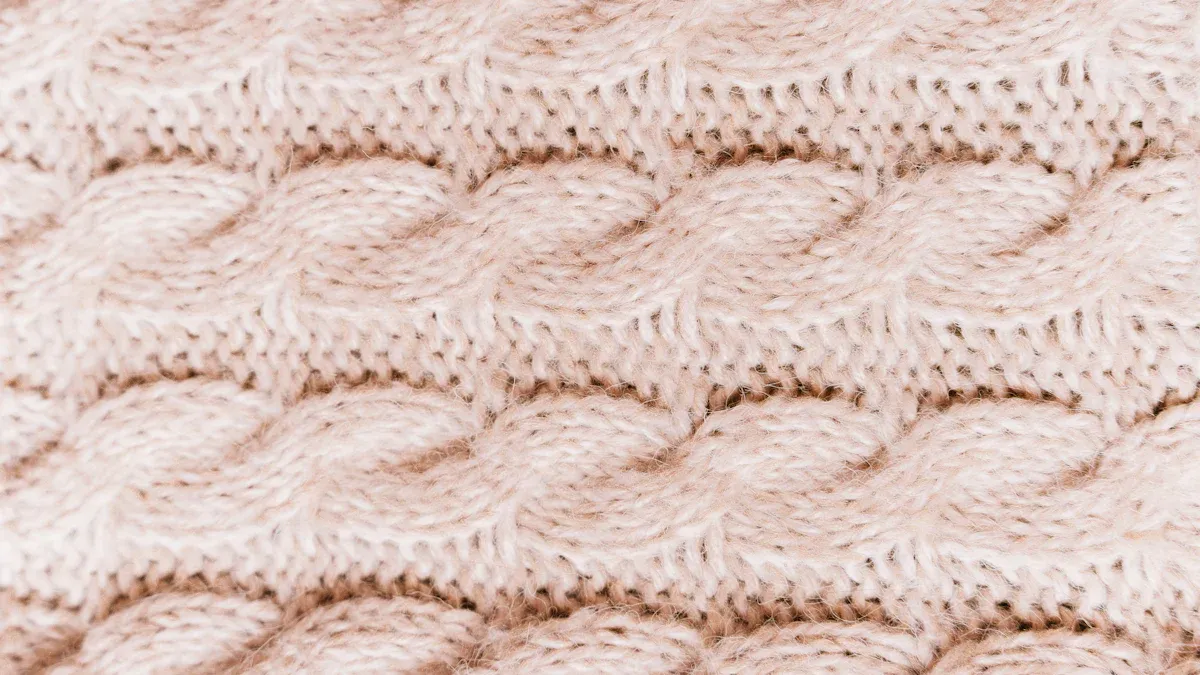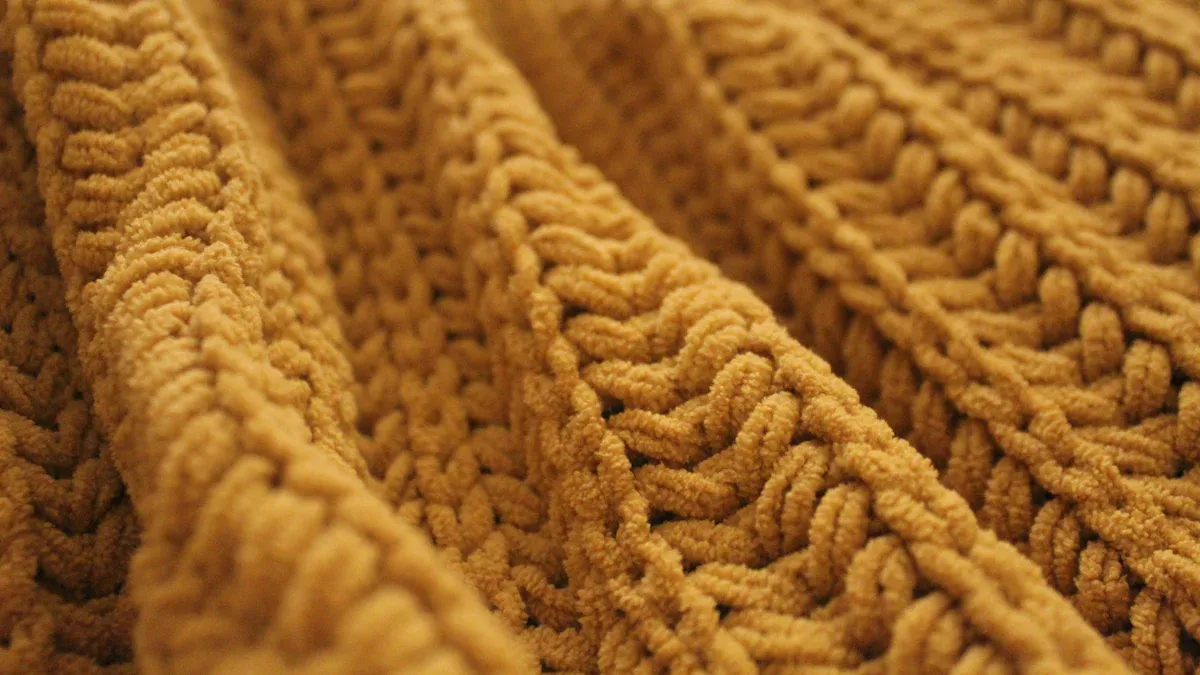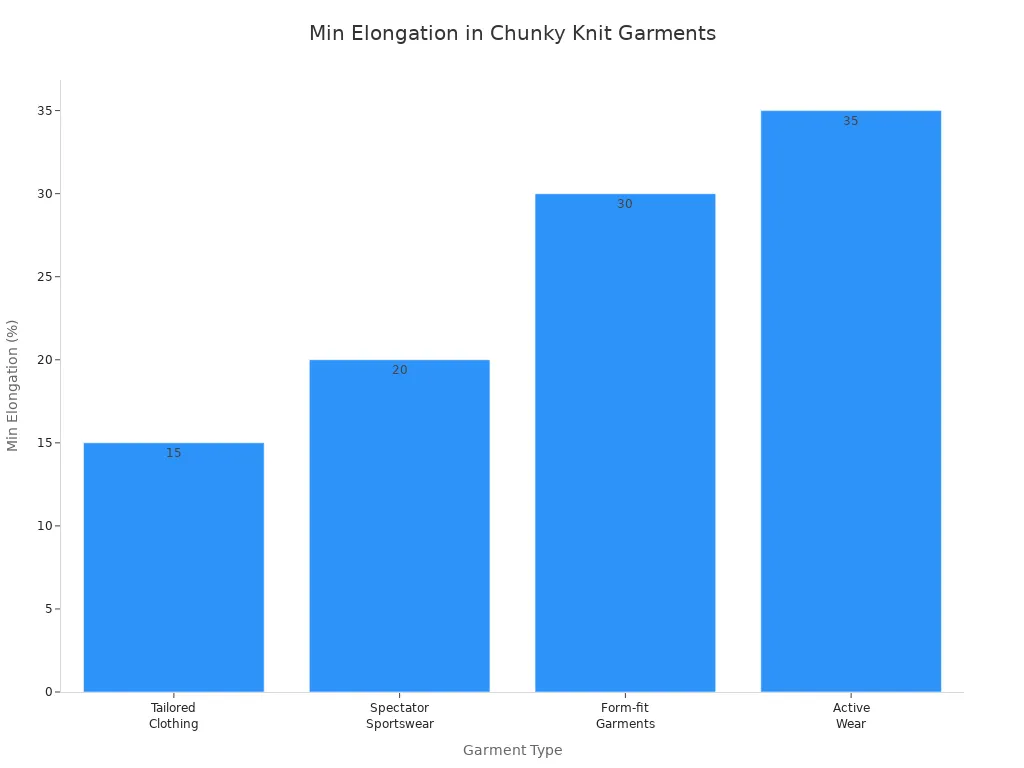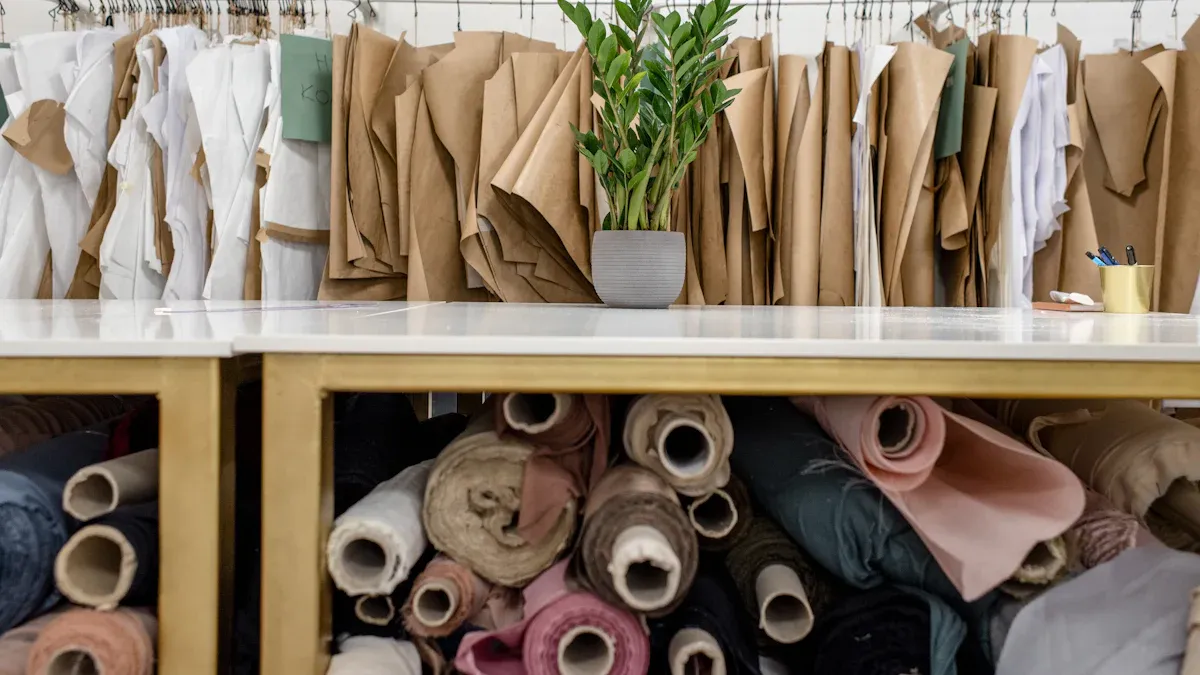
Choosing the right fabric can make your sewing project easier and more fun. When you work with heavy weight chunky knit fabric, you need to pay attention to details like weight, stretch, and structure. Pick up the fabric and feel it. Look closely at how it drapes. Think about what you want to create and how the fabric will move. Sometimes, you might need to change your sewing technique for thicker knits.
Key Takeaways
Pick heavy weight chunky knit fabric that fits your project’s pattern. This helps your project look and fit better. Touch the fabric to feel its weight, stretch, and how it hangs. Do this before you buy it. This makes sure it feels good and holds its shape. Use special sewing methods like a ballpoint needle and a hump jumper. These tools help you sew thick seams without problems. Always look at the fiber content and care instructions. This keeps your clothes soft, strong, and easy to clean. Try out fabric samples and read labels or reviews. This helps you avoid problems and choose the right fabric with confidence.
Project Needs
Garment Type
When you start a new project, think about what you want to make. Heavy weight chunky knit fabric works best for certain patterns. You often see it used for:
Sweaters
Cardigans
Vests
Chunky sweaters with cable designs
Handmade accessories like beanies, gloves, and scarves
If you want to sew chunky sweaters or cozy cardigans, this fabric is a great choice. It gives your projects a warm and stylish look. Some patterns, like fitted tops or dresses, may not work well with thick knits. Always match your fabric to the pattern for the best results.
Drape and Structure
Drape means how the fabric hangs or moves. Heavy weight chunky knit fabric feels thick and sturdy. It does not flow or fold softly like lighter knits. Instead, it holds its shape and gives your garment more structure. This makes it perfect for patterns that need a defined shape, like jackets or structured sweaters. If you want a relaxed, flowing look, lighter knits work better. Think of chunky knits as a necklace made of big beads—stiff and bold—while lighter knits are like a soft chain that drapes easily.
Tip: Check the pattern instructions to see if they suggest a specific fabric weight. This helps you pick the right fabric for your project.
Comfort
Comfort matters in every sewing project. Heavy weight chunky knit fabric feels soft and cozy, but several things affect how comfortable it is. The softness, flexibility, and surface texture all play a part. If the fabric feels smooth and gentle against your skin, you will enjoy wearing it. Good chunky knits also let air pass through, so you stay warm but not too hot. Some fabrics manage moisture better, keeping you dry and comfortable. Always touch the fabric and check how it feels before you start your project.
Heavy Weight Chunky Knit Fabric

Weight and Thickness
When you pick up a heavy weight chunky knit fabric, you can feel its thickness right away. Most of these fabrics weigh between 8 and 14 ounces per yard or meter. This weight gives your projects a cozy, sturdy feel. You might notice that thicker fabrics work best for loose-fitting garments like sweaters, cardigans, and pullovers. If you try to use them for tight-fitting clothes, you could end up with bulky seams and less comfort.
Here are some tips for handling thick knits:
Use a “hump jumper” or a shim under your presser foot when sewing thick seams. This keeps your stitches even.
Press seams with steam and a gentle touch to flatten them without harming the fabric.
Trim and grade seam allowances to reduce bulk.
Avoid invisible zippers. Traditional zippers work better with heavy fabrics.
Note: If you use a serger, adjust the settings. Increase the stitch width and length, and set the differential feed higher to keep seams flat and smooth.
You may need to use lighter weight fabrics for facings or pockets. This helps your garment feel more comfortable and fit better.
Stretch and Recovery
Stretch is a big part of what makes knit fabrics special. Heavy weight chunky knit fabric usually has at least 15% stretch. This means it can expand and move with your body, but it may not stretch as much as lighter knits. The amount of stretch you need depends on what you are making. For example, a chunky sweater needs less stretch than activewear.
Here’s a quick look at how stretch affects different garments:
Garment Type | Minimum Elongation (%) | Impact on Garment Fit and Use |
|---|---|---|
Tailored Clothing | 15–25 | Gives basic stretch for comfort and keeps the shape. |
Spectator Sportswear | 20–35 | Offers more stretch for easy movement. |
Form-fit Garments | 30–40 | Needs higher stretch for a close fit and better mobility. |
Active Wear | 35–50 | Maximum stretch for sports and lots of movement. |

Recovery is just as important as stretch. Good recovery means the fabric snaps back to its original shape after you stretch it. If your heavy weight chunky knit fabric has poor recovery, your sweater or cardigan might get baggy over time. Rib knits, which are one of the most popular types of knit fabrics, have great recovery. They keep their shape even after lots of wear and washing. Jersey knits, on the other hand, are softer but may not bounce back as well.
Tip: If you want your garment to last, look for chunky knits with strong elastic recovery. This helps your clothes keep their shape and look new longer.
Stability
Stability means how well the fabric holds its shape and resists stretching out. Some heavy weight chunky knit fabrics, like double knits, are very stable. Double knit is made with two layers of fabric joined together, so it feels thick and sturdy. It does not curl at the edges and looks the same on both sides. This makes it perfect for structured garments that need to keep their shape.
Here’s a quick comparison of double knit stability:
Characteristic | Description |
|---|---|
Stability | Very stable, keeps its shape, and does not curl at the edges. |
Thickness & Weight | Medium to heavy weights, sturdy and durable. |
Edge Behavior | Smooth, non-curling edges. |
Shape Retention | Excellent, resists wrinkles and shrinking. |
Durability | Strong, great for structured garments. |
Reversibility | Looks the same on both sides. |
Stable knits, like double knits, are easier to sew than stretchier knits. They behave more like woven fabrics, so you get fewer problems with puckering or stretching. If you use less stable chunky knits, handle them carefully. Use stretch stitches and ballpoint needles to avoid snags. Adding interfacing or stabilizers can help support your fabric and keep your seams looking neat.
Note: For very heavy or dense fabrics, use a heavier stabilizer. This keeps your stitches from pulling or distorting the fabric.
When you choose the right stability for your project, sewing becomes easier and your finished garment looks more professional. Remember, not all types of knit fabrics act the same way. Double knits offer more structure, while other chunky knits may need extra care during sewing.
Sweater Knit Fabric Qualities
Fiber Content
When you pick out sweater knit fabric, you should always check the fiber content. The fibers in your fabric decide how warm, soft, and easy to care for your finished project will be. Here are some of the most common fibers you’ll find in heavy weight chunky knits:
Wool keeps you warm and cozy. It holds heat well and wicks away moisture, so you stay dry. Wool works great for chunky sweaters, hats, and scarves in cold weather.
Polyester fleece feels thick and plush. Its brushed surface traps air, which helps you stay warm even on chilly days.
Some blends include synthetic fibers like spandex. These add stretch and make your fabric more durable, but you won’t see them as often in heavy weight chunky knits.
These fibers make sweater knit fabric thick, warm, and perfect for outdoor wear. You get insulation, moisture control, and long-lasting comfort.
Tip: Always check the care label. Wool needs gentle washing or dry cleaning. Polyester is easier to care for and resists shrinking. Blends may need special care, so follow the instructions to keep your fabric looking new.
Fiber content also changes how you care for your fabric. Wool needs gentle handling to avoid shrinking or felting. Cotton feels soft and breathes well, but it can wrinkle and shrink if you don’t wash it carefully. Polyester and acrylic are strong and easy to wash. They don’t shrink or felt, so they’re great for busy people who want low-maintenance clothes. If you choose a blend, you get a mix of these qualities. Always read the care instructions to keep your chunky knits in top shape.
Texture and Appearance
Sweater knit fabric stands out because of its texture and look. You’ll notice that heavy weight chunky knits feel thick and have a bold, three-dimensional surface. This texture adds depth and makes your garment look interesting and cozy. Let’s compare some types of sweater knits and lighter knits:
Knit Fabric Type | Texture and Appearance Features | Weight and Structure Characteristics |
|---|---|---|
Cable Knit | Raised, interwoven, three-dimensional cable or rope-like patterns; pronounced texture and depth | Thick, chunky, provides warmth and volume; classic textured look |
Smooth, polished surface on both sides; stable and less prone to curling | Thick, double-layered, stable, structured, refined appearance | |
Interlock Knit | Smooth surface on both sides; soft with excellent drape and stability | Thicker and more stable than jersey; durable and less curling |
Lighter Knits (e.g., Jersey, Pointelle) | Thinner, softer, smoother or delicate openwork textures; less pronounced texture | Lightweight, flexible, more drape and stretch; less structure |
The texture of heavy weight chunky knit fabric changes how your finished garment looks. Chunky knits add visual interest and make colors look softer. The raised patterns create shadows and highlights, giving your clothes a rich, cozy feel. You get volume and presence, which works well for outerwear or structured pieces. If you want your garment to stand out, choose a chunky knit with a bold texture. Just remember, these fabrics can look heavy, so balance them with lighter pieces or simple styles.
Warmth and Breathability
You want your sweater knit fabric to keep you warm, but you also want it to breathe. Heavy weight chunky knits do a great job at holding in heat. Rib and purl knits, for example, have more thickness and structure, so they trap more air and keep you warmer than plain knits. Honeycomb knits also offer great insulation. The thicker and heavier your fabric, the more warmth you get.
Breathability depends on how tightly the fabric is knit and how thick the yarns are. Chunky knits use thick yarns and tight stitches, so they let in less air than lighter knits. If you hold your fabric up to the light and see very little light coming through, it means the fabric is less breathable. Lighter knits like cotton jersey let more air pass through, so they feel cooler and work better for warm weather.
Knit fabrics, in general, breathe better than woven fabrics because of their looped structure. Still, within the types of knit fabrics, heavy weight chunky knits give you more warmth and less airflow. This makes them perfect for winter clothes and outdoor wear. You stay warm, but you might not want to wear them on a hot day.
Note: If you want a balance between warmth and breathability, look for blends or knits with a looser structure. These let in more air while still keeping you cozy.
Fabric Quality
Durability
When you want your chunky knit project to last, you need to think about durability. Heavier fabrics usually stand up better to wear and tear. If you plan to make outerwear or something you’ll wear a lot, pick a knit with a higher fabric weight. Blends with synthetic fibers like polyester or spandex add even more strength. Double knits are a great choice because their thick, structured build makes them tough. You also want a fabric that can handle washing without falling apart. Good stretch and recovery help your garment keep its shape, even after many wears.
Look for these signs of durability:
Synthetic blends
Structured construction (like double knits)
Washability
Strong stretch and recovery
Pilling Resistance
No one likes little fuzz balls on their clothes. Pilling happens when fibers break and tangle on the surface. Some chunky knits resist pilling better than others. Synthetic fibers like polyester and nylon usually pill less than natural fibers like wool or cotton. Yarns with a tighter twist hold fibers together, so you see fewer pills. Finishing treatments, like singeing or special washes, can also help. Tighter, denser knits keep fibers from moving around and forming pills.
Tip: If you want a sweater that stays smooth, choose a chunky knit with synthetic fibers, tight yarn twist, and a dense knit.
Stitch Definition
Stitch definition means how clearly you can see each stitch in your finished project. Chunky knits with smooth, even surfaces show off cables, ribs, and textured patterns. If you love bold designs, pick a knit with good stitch definition. Yarns that are tightly spun and not too fuzzy work best. Double knits and interlock knits often give you crisp, clean lines.
Care
Taking care of your chunky knit fabric helps it last longer and look better. Here’s how you can keep your projects in top shape:
Wash gently by hand or use a delicate machine cycle with cold water.
Turn garments inside out before washing.
Use mild detergent and skip fabric softeners.
Wash only when needed to avoid extra wear.
Use a mesh bag in the washer to protect the fabric.
Air dry flat—don’t use high heat or hang heavy knits.
Store folded in a cool, dry place away from sunlight.
Iron on the reverse side with low heat if needed.
Spot clean stains gently.
Always check the care label for special instructions.
Remember: Gentle care keeps your chunky knits looking new and feeling cozy!
Compare Fabrics

Swatch Testing
Swatch testing is one of the smartest steps you can take before starting your project. When you get a small piece of fabric, you can touch it, stretch it, and see how it feels against your skin. You can check the thickness, texture, and color in real life. Try washing and ironing your swatch. Sometimes, chunky knits change after washing—they might get softer, flatter, or even shrink a bit. This helps you see how your finished garment will look and feel.
Swatch testing lets you:
Feel the fabric’s warmth and breathability.
Test for shrinkage and color changes after washing.
Check how the fabric stretches and recovers.
Plan your design by seeing how the fabric looks with your pattern.
Spot any problems, like tension issues or pilling, before you sew the whole project.
Tip: Keep notes about your swatch tests. Write down how the fabric reacts to washing, pressing, and sewing. These notes help you remember what works best.
In-Store vs. Online
Shopping in-store gives you a big advantage. You can touch the fabric, squeeze it, and drape it over your arm. This helps you judge the thickness, softness, and stretch right away. You can also see the true color and texture under store lights. If you shop online, you don’t get to feel the fabric. Instead, order swatches if the store offers them. Look for close-up photos and read the product details carefully.
Shopping Method | What You Can Do | What You Might Miss |
|---|---|---|
In-Store | Feel, drape, and inspect | Sometimes limited stock |
Online | Order swatches, read details | Can’t touch before buying |
Note: Always check the return policy when buying fabric online, just in case it’s not what you expected.
Reviews and Labels
Reading fabric labels and reviews can save you from surprises. Labels tell you the fabric’s weight (like GSM or ounces per yard), fiber content, and care instructions. This info helps you know if the fabric is heavy enough for your project and how to care for it. Reviews from other sewists often mention things like stretch, recovery, and how the fabric holds up after washing.
Look for these details on labels and in reviews:
Stability and durability
Washing and care tips
When you combine what you learn from swatch testing, in-store or online shopping, and reading labels and reviews, you make smarter choices. Your finished project will look and feel just right!
Mistakes to Avoid
Overlooking Stretch
You might think all chunky knits stretch the same way, but that’s not true. Each fabric can stretch in different directions and amounts. If you skip checking the stretch, your finished garment might not fit or feel right. Here’s what can go wrong:
Knit fabrics stretch both lengthwise and widthwise, which helps your clothes fit better.
Patterns for knits often skip extra darts or shaping because the fabric’s stretch does the work.
If you don’t measure the stretch, your garment could end up too tight, too loose, or even lose its shape after wearing.
Some chunky knits have great recovery, snapping back to their original shape. Others might bag out and look sloppy.
Fabrics with elastane or Lycra bounce back better, which is important for close-fitting clothes.
Tip: Always test the stretch before you start sewing. Pull the fabric gently and see how much it stretches and returns.
Ignoring Care
Taking care of heavy weight chunky knit fabric is just as important as picking the right one. If you ignore the care instructions, you could ruin your hard work. Here’s what can happen:
Consequence Category | Explanation |
|---|---|
Water and heat can shrink or stretch your fabric. Hanging wet knits stretches them out, especially at the shoulders. | |
Irreversible Fiber Damage | High heat can make fibers weak, brittle, or cause pilling. |
Color Fading & Bleeding | Heat and sunlight can fade colors or make them bleed onto other clothes. |
Improper Drying Methods | Hanging or tumble drying can stretch or damage the fabric. |
Financial & Reputational Impact | Damaged garments waste money and can hurt your reputation if you sew for others. |
Remember: Always follow the care label. Wash gently, dry flat, and avoid high heat to keep your chunky knits looking great.
Wrong Fabric Choice
Choosing the wrong type of chunky knit can turn your sewing project into a struggle. Not all heavy weight knits work for every pattern. Here’s what can go wrong:
Using the wrong knit can make your garment stiff, uncomfortable, or hard to fit.
Bulky fabric can ruin the look and drape of your design.
If the fabric doesn’t drape right, your garment won’t hang or move as you want.
Sewing with the wrong knit can cause seams to stretch, distort, or even break.
Picking a fabric that doesn’t match your project can hurt fit, comfort, and durability.
Before you start sewing, match your fabric to your pattern and test how it behaves. This helps you avoid surprises and get the best results.
Choosing the right chunky knit fabric can make your sewing project a success. You want to match fabric weight, stretch, and structure to your pattern so your clothes fit well and feel comfortable. Always check labels for fiber content and care tips, then test swatches to see how the fabric acts.
When you use these steps, you pick fabric with confidence and create garments that look and feel great.
FAQ
How do I know if a chunky knit fabric is too heavy for my project?
Pick up the fabric and feel its weight. If it feels stiff or bulky, it might not work for lighter garments. Always check your pattern’s fabric recommendations before you buy.
Can I sew heavy weight chunky knits with a regular sewing machine?
Yes, you can! Use a ballpoint needle and a stretch stitch. Go slow over thick seams. If your machine struggles, try a walking foot for smoother sewing.
What’s the best way to prevent chunky knits from stretching out?
Lay your garment flat to dry. Avoid hanging it, as this can stretch the fabric. Use stay tape or clear elastic in shoulder seams for extra support.
Do I need to pre-wash chunky knit fabric before sewing?
Yes, you should pre-wash it. This helps prevent shrinking or color bleeding later. Wash the fabric gently and lay it flat to dry before you start cutting.
How can I stop chunky knits from unraveling at the edges?
Use a zigzag stitch or a serger on the raw edges. This keeps the fabric from fraying. You can also use a little fabric glue for extra security.









